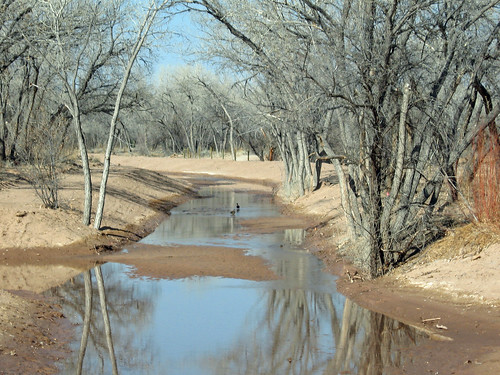In thinking about the effects of climate change on our arid landscape, it’s easy to get distracted by precipitation numbers. Will it go up or down? How much? What’s the error bar look like? But in recent years, the research community that looks at the Southwestern U.S. has been banging away on “P minus E”. It’s not just the precipitation. It’s precipitation minus evaporation. Or, to be a bit more specific when looking at riparian systems in arid landscapes, evaporation (open water) and transpiration (the plants that live on a river’s groundwater).

Water in the Rio Grande Bosque
In this morning’s Albuquerque Journal, I have a story (ad/sub req.) looking at this point through the latest research to tackle the question, by UNM climate scientist David Gutzler and research student Tessia Robbins. Journal photographer Greg Sorber and I went out to a stretch of bosque (the woods along the Rio Grande) to a site where scientists measure evapotranspiration:
In the summer, this stretch of bosque can lose the equivalent of a layer of water a quarter of an inch deep every day — far more than falls from the sky. The warmer it gets, the more this landscape dries out.
It is not the rain and snow that matters most, scientists like Cleverly say. It is the evaporation.
As Earth’s climate warms, scientists expect years-long dry spells and wet spells to continue, just as we have seen in the past.
But with warmer temperatures and the resulting increase in evaporation, it will be harder to recover from the dry spells, according to a new analysis by University of New Mexico professor David Gutzler and UNM research student Tessia Robbins.
“We’ll go into a big drought some time in the 21st century,” Gutzler said, “and we just may not pull out of it.”

As John Bredehoeft, former Western head of the USGS and all around eminence grise of groundwater says and re-says, “It’s the discharge!” That may be why since leaving the survey and forming his own company (Hydrodynamics Group) Bredehoeft has been so active taking stands against groundwater mining. He works particularly closely with the Taos water lawyer Simeon Herskovits. Excellent post.
So what happens to the water? Does it just stay in the atmosphere or does it eventually rain down somewhere leaving a surplus of water?
Pingback: Twitter Trackbacks for jfleck at inkstain » Stuff I Wrote Elsewhere: It’s All About the Evaporation [inkstain.net] on Topsy.com
Greg – Mostly it just stays in the air. The air always has lots of moisture in it, even “dry” air. It just gets ever-so-slightly moister, and warm air in general tends to hold more water.
Great article, John.
Does it all stay in the air, or does some end up as increased precip in the tropics?
(Er, have times now gotten so tough at “you’re” newspaper that copy editors no longer check all the way to the end?)
I’m guessing that as it gets warmer and drier, T (transpiration) also increases along with E (evaporation). This double whammy being subtracted from P (percipitation) will likely be the sobering reality.
See Gerald North of Texas A&M, starting around p.7 especially.
Basically, at a given temperature, there’s some amount of water in the atmosphere, more with higher temperature. At steady-state, there has to be as much precipitation as evaporation in the world as a whole.
However, *where* it rains moves around.
“Hadley Cell expansion” basically says more of New Mexico’s rain will move further NorthEast, and all the models expect this happens with warmer temperatures.
Exactly. That’s why Elephant Butte is an abomination in a state with little water. Take a look at those evaporation figures for an eye opener.
Pingback: jfleck at inkstain » How Dry Southern California?